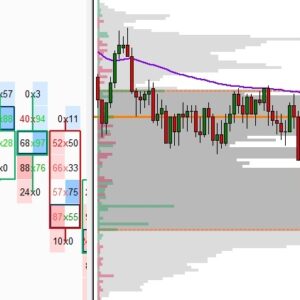This article delves into the sophisticated world of professional trading, specifically examining the strategies and techniques employed by The Private Banker. We will explore the core pillars that underpin their success, emphasizing the importance of risk management and a structured approach to market analysis.
The Pillars of Professional Trading: A Private Banker’s Perspective

The excerpt from Professional Trading Strategies and Techniques reveals a robust, multi-faceted approach to trading, significantly different from retail trading strategies. Professional traders like The Private Banker don’t just react to market fluctuations; they proactively shape their approach based on a deep understanding of market dynamics and rigorous risk management. This disciplined methodology sets them apart, leading to consistent, sustainable profitability. This section will dissect the foundational pillars supporting their success.
Top-Down Technical Analysis: Filtering the Noise
The Private Banker’s approach emphasizes a top-down, hierarchical analysis. This isn’t simply identifying chart patterns; it’s about constructing a robust trading narrative that aligns with the broader market context. Starting from macro-level observations (like overall market sentiment and economic indicators), they progressively zoom into micro-level details (specific chart patterns and volume analysis). This holistic view allows filtering out market noise and identifying the “path of least resistance”. This is crucial; attempting to profit from short-term noise without understanding the bigger picture is akin to predicting individual raindrops rather than weather patterns.
The process starts with assessing broad market balances and imbalances, conceptual framing that sets the foundation for the entire trade plan. This macro view provides the context for the subsequent use of more granular tools like VWAP (Volume Weighted Average Price) and market profile. VWAP periods can then decipher specific market contexts, anchoring decisions and offering a crucial understanding of buyer/seller dynamics. Tools like Volume Profile and Market Profile add granularity, helping identify areas of support and resistance and potential price movement. The core idea is to use these technical tools, not in isolation, but as interlocking pieces of a larger puzzle that reveals a clear picture of market sentiment and potential trade opportunities. They are filters, refining the initial macro analysis. This systematic approach reduces emotional decision-making leading to better overall risk management.
It’s not about finding a single perfect indicator but building a cohesive understanding through multiple interwoven viewpoints. By understanding the interactions of these various tools and what type of confirmation one seeks, the private banker is not overwhelmed by the multitude of available data. Moreover, this systematic and layered approach to analysis is reproducible and can be consistently applied, eliminating some ambiguity and uncertainty often encountered in ad-hoc trading strategies. The ability to systematically analyze the market across multiple timeframes allows for identifying higher-probability trade setups which greatly enhance the trading strategy.
Risk Management: The Cornerstone of Success
The Private Banker’s methodology emphasizes risk management as the most critical element. This isn’t simply about setting stop-losses; it’s a holistic approach encompassing financial, technological, settlement, disaster, opportunity, event, and even psychological risks. The simple act of defining risk is crucial – the lack of quantifiable risk-reward analysis is one of the biggest flaws in many retail trading accounts. Retail traders may focus on the potential reward but ignore the potential losses. A private banker, however, would carefully calculate the max loss on every single trade. This proactive and comprehensive risk assessment ensures that even unexpected events are accounted for.
For instance, psychological risk, often underestimated, can lead to emotional trading decisions. The Private Banker’s methodology accounts for this by incorporating disciplined trading plans and adherence to pre-defined risk parameters. This mitigates the impact of fear and greed emotions. By objectively assessing these risks and devising mitigation strategies, professional traders create a far more secure and predictable trading environment, protecting themselves in ways that inexperienced traders don’t even begin to consider.
This holistic risk management process allows for a deeper understanding of the trade beyond a simple stop-loss order. It also creates a mindset focused on protecting capital above all. It’s about minimizing potential downsides rather than solely maximizing potential upwards gains, a principle often overlooked in retail trading. This leads to far better long-term viability for the Private Banker’s overall portfolio. The Private Banker’s approach is a significant improvement on other trading approaches because it takes in risk management as an overarching theme that impacts how each decision is made.
Trade Methodology: Structuring the Approach
The Private Banker employs a meticulous trade methodology, incorporating specific tools and filters to enhance their trading efficacy. They don’t simply react to market movements; they plan their trades proactively by using general filters applied consistently to each session. These filters are then integrated with their game plan. This pre-defined strategy, tailored to current market dynamics, guides their decision-making. These are not random entries or exits – instead they are calculated decisions within a carefully constructed framework.
This structured approach utilizes advanced charting techniques such as TPO (Time Price Opportunity) profiles, Volume profiles, and Footprint charts. These tools aren’t just visually appealing; they provide in-depth insights into price action and volume distribution, helping identify areas of congestion and potential breakouts, and the relative strength of various market moves. This detailed, multifaceted analysis reduces uncertainty and increases the likelihood of identifying high-probability trading opportunities.
By employing these tools strategically, Private Bankers refine their decision-making process. They aren’t just reacting to price changes, but interpreting the underlying order book dynamics and the actual demand of the market. These advanced tools combined with a predefined game plan create a methodology capable of consistently producing winning trades. The methodology also includes continuously evaluating trade performance to continually refine trading strategies, creating a feedback loop that enhances future performance. This continual improvement is essential for long-term success in the ever-evolving market.
Trading Research: Continuous Learning and Refinement
The Private Banker’s commitment to continuous learning and research is paramount. They understand that market dynamics are constantly evolving, requiring a flexible and adaptable approach. This emphasizes the continual gathering and analysis of data which supports the development of increasingly sophisticated and profitable strategies. They actively utilize resources like handbooks, chartbooks, videos, and market insights to stay abreast of the latest market trends and refine their strategies accordingly, fostering a deeper knowledge which goes beyond the technical. They don’t just utilize readily available data – they take a more active part in research.
Their research goes beyond just price action, and they utilize metrics like Cumulative Delta (CD) to understand the relative power of buying and selling pressure, allowing analysis of the depth and direction of market strength. They investigate not just “what” happened in the market; they also seek to understand the “why” behind certain price movements. Focusing on types of value and analyzing what drives value in the markets is necessary to properly understanding the underlying dynamics at play. This approach leads to a more nuanced understanding of market behaviour and supports making more informed decisions.
This commitment to ongoing research contributes significantly to their ability to adapt to changing market conditions. They approach trading not as a fixed system but as a journey of continuous learning and refinement. This iterative approach supports long-term success, allowing them to anticipate and navigate market shifts more effectively. The data driven nature of their research is then applied in feedback loop to other aspects of the trading process including the development of filters, further reinforcing the importance of research and analysis in their methodology. The private banker does not use research as a passive tool. They actively use it to shape their trading actions.
Conclusion
The Private Banker’s approach to professional trading reveals a powerful and sophisticated methodology built on four cornerstones: a hierarchical top-down technical analysis system which acts as a filter to identify high probability trades, meticulous risk management that encompasses multiple risk categories, a structured trade methodology employing advanced tools, and a commitment to continuous research and learning. The emphasis on risk management above all else demonstrates a commitment to capital preservation. The successful integration of these elements is what separates the Professional traders from the retail traders. This rigorous method provides a framework for consistent, sustainable profitability and illustrates why their unique strategy surpasses less sophisticated approaches.
Sales Page:_https://leprivatebanker.com/trading-educational-content-summary/






Reviews
There are no reviews yet.